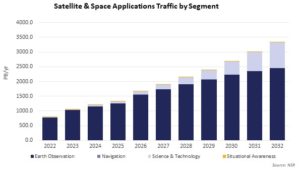The implications of increasing Earth observation data
Earth observation (EO) is unequivocally a critical asset in understanding and safeguarding our planet. The significance of EO data has taken on new dimensions as its volume skyrockets. The ever-increasing capacity to collect, transmit, and analyse data from space offers unparalleled insights but also presents profound challenges. According to NSR’s Space Traffic Study report, 3rd Edition, Earth observation data will generate about 2 Exabytes (EB) by 2032, growing at a CAGR of 11%. EO data accounted for about 86% of the cumulative data generated by the Space applications segment, for the forecast period.

Advancements in sensor technology have allowed for capturing higher-resolution images, by improving the quality of the sensors and optics manufacturing technology, which in turn generates larger datasets. Hyperspectral imaging has been rapidly developing over the past decade, and modern sensor technologies can cover large areas with exceptional spatial, spectral, and temporal resolutions.
Additionally, the development of more sophisticated image processing algorithms, including noise reduction and image stabilization, further boosts image quality. These cumulative advancements empower cameras to deliver crisper, more detailed images with greater dynamic range and improved performance across a range of photographic scenarios. Also, the emergence of satellite constellations designed for frequent revisit times will lead to more regular data streams across the forecast period.
Commercial vs Government Traffic
The rising interest in satellite capabilities shown by governments and businesses worldwide, along with easier satellite data usage, have led to an increase in the demand for satellite-driven solutions by end-users. Commercial players leverage EO data for competitive advantage and economic growth, whereas government agencies prioritize public welfare and the advancement of knowledge, resulting in differing approaches to data acquisition, sharing, and the management of space assets.
While government and military organizations have been relatively cautious in embracing public cloud infrastructures, primarily due to concerns surrounding data sovereignty and security, the evolving trend toward the adoption of commercial solutions within these sectors underscores the growing significance of cloud services for government and military entities. This shift has led to the development of new cloud technologies that are more secure, reliable and scalable than ever before.
Handling Data Challenges
The massive volumes of EO data now present significant challenges in terms of data storage, transmission, and processing. Data analysis also becomes more sophisticated, requiring investments in algorithms, computing resources, and skilled personnel to extract valuable insights from the data.
The increased availability of EO data creates opportunities for commercial entities to provide value-added services, driving innovation and economic growth in various sectors. Organizations and agencies must invest in robust infrastructure and data management systems to handle this growing data traffic effectively.
Satellite operators should build or upgrade ground stations capable of handling larger data volumes with improved data transmission rates. Stake holders should continue investing in infrastructure, including satellite constellations, ground stations, and data centres, to accommodate growing data traffic. The increasing use of radio frequencies for data transmission from Earth observation satellites necessitates efficient spectrum management to prevent interference and ensure that the needs of all users are met.
NASA has awarded about USD 278.5 million in contracts to six American Satcom companies to develop commercial near-Earth space communication services, under the Communications Services Project (CSP). Inmarsat, Kuiper, SES, SpaceX, Telesat and Viasat, will help develop high-rate and high-capacity two-way communications to replace NASA’s aging Tracking and Data Relay Satellite System (TDRSS) constellation, which provides information relay services to the International Space Station, Hubble Space Telescope, and other missions. The resulting satcom systems will be designed to serve both NASA mission requirements and commercial customers.
Space data relay systems play a pivotal role in managing space data traffic by serving as crucial communication bridges between Earth and spacecraft. Commercial players will increasingly provide a key service, replacing legacy government-owned and operated networks. These systems facilitate continuous data transmission and reception, particularly for satellites in low Earth orbit (LEO) that might face line-of-sight limitations with ground stations. Overall, more flexibility in moving data across the space domain is necessary to leverage the advances in sensor resolution and the number of spacecraft in orbit.
The Bottom Line
The increasing availability of EO data has led to the development of new applications and services that can benefit society in many ways. By reducing latency, providing global connectivity, enabling communication and supporting applications ranging from emergency response and scientific research to commercial and military operations, space data relay systems ensure that the ever-increasing volume of space data traffic is efficiently and reliably transmitted, enhancing the capabilities and reach of space-based activities.
